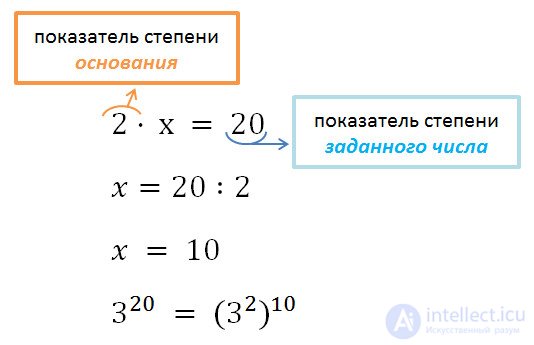Lecture
We remind you that in this lesson, the properties of degrees with natural indicators and zero are dealt with. Degrees with rational indicators and their properties will be discussed in lessons for 8 classes.
A degree with a natural index has several important properties that allow you to simplify calculations in examples with degrees.
When multiplying degrees with the same bases, the base remains unchanged, and the exponents are added.
a m • a n = a m + n , where a is any number, and m, n are any positive integers.
This property of degrees also acts on the product of three or more degrees.
Examples
Note that in this property it was only about multiplying degrees with the same bases . It does not relate to their addition.
You cannot replace the sum (3 3 + 3 2 ) with 3 3 . This is understandable if you count 3 3 = 27 and 3 2 = 9; 27 + 9 = 36, and 3 5 = 243
When dividing the degrees with the same bases, the base remains unchanged, and the divisor degree is subtracted from the divisible index.
a m • a n = a m - n , where a is any number that does not equal zero, and m, n are any positive integers such that m> n.
Examples
| 11 3 • 4 2 |
| 11 2 • 4 |
Using properties No. 1 and No. 2, you can easily simplify expressions and make calculations.
| 512 • 4 |
| 32 |
| 512 • 4 |
| 32 |
| 2 9 • 2 2 |
| 2 5 |
| 2 9 + 2 |
| 2 5 |
| 2 11 |
| 2 5 |
Note that in property 2, it was only about the division of degrees with the same bases.
You can not replace the difference (4 3 - 4 2 ) to 4 1 . This is understandable if you count 4 3 = 64 and 4 2 = 16; 64 - 16 = 48, and 4 1 = 4
Be careful!
When raising a degree to a power, the base of the power remains unchanged, and the exponents are multiplied.
(a n ) m = a n • m , where a is any number, and m, n are any positive integers.
According to the property of raising a degree to a power , it is known that when building to a power, the indicators are multiplied, which means

When raising a degree to a power, each factor is raised to this power and the results are multiplied.
(a • b) n = a n • b n , where a, b are any rational numbers; n is any natural number.
Note that property No. 4, like other properties of degrees, is also applied in the reverse order.
(a n • b n ) = (a • b) nThat is, to multiply the degree with the same indicators, you can multiply the base, and the exponent to leave unchanged.
In more complex examples, there may be cases when multiplication and division need to be performed on powers with different bases and different indicators. In this case, we advise you to proceed as follows.
For example, 4 5 • 3 2 = 4 3 • 4 2 • 3 2 = 4 3 • (4 • 3) 2 = 64 • 12 2 = 64 • 144 = 9216
Example of raising to the power of decimal fraction.
4 21 • (-0.25) 20 = 4 • 4 20 • (-0.25) 20 = 4 • (4 • (-0.25)) 20 = 4 • (- 1) 20 = 4 • 1 = fourIn order to raise to a power a quotient, one can build to this power a separate dividend and a divisor, and divide the first result by the second.
(a: b) n = a n : b n , where a, b are any rational numbers, b ≠ 0, n is any natural number.
Property of the degree of zero:
Any number other than zero raised to the power zero equals 1:
a^0 = 1, (provided that a ≠ 0)
Degree 1 property:
Any number raised to the power of 1 is equal to itself:
a^1 = a
We remind you that the quotient can be represented as a fraction. Therefore, we will dwell on the next page on the topic of raising a fraction to a power.
Comments
To leave a comment
Arithmetic
Terms: Arithmetic